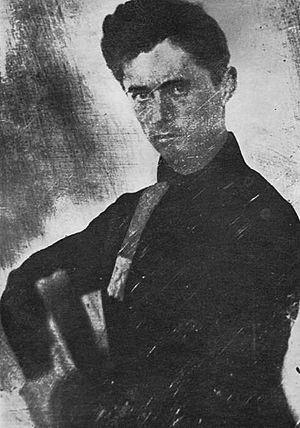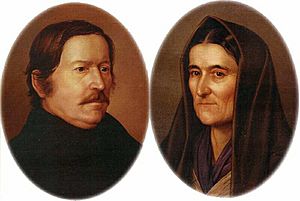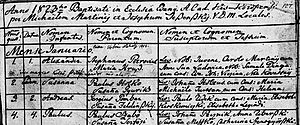Sándor Petőfi facts for kids
Quick facts for kids
Sándor Petőfi
Alexander Petrovics (la) |
|
|---|---|

Portrait of Petőfi painted by Miklós Barabás
|
|
| Born | Sándor Petrovics 1 January 1823 Kiskőrös, Kingdom of Hungary, Austrian Empire |
| Died | 31 July 1849 (aged 26) (presumed) Fehéregyháza, Grand Principality of Transylvania, Austrian Empire (now Albești, Romania) |
| Occupation | Poet, revolutionary |
| Language | Hungarian |
| Period | 1842–1849 |
| Notable works | National Song, John the Valiant |
| Spouse |
Júlia Szendrey
(m. 1847) |
| Children | Zoltán Petőfi |
| Parents |
|
| Political party | Opposition Party |
|
Philosophy career |
|
|
Influences
|
|
|
Influenced
|
|
Sándor Petőfi (Hungarian: [ˈʃaːndor ˈpɛtøːfi] []; born Petrovics; 1 January 1823 – most likely 31 July 1849) was a famous Hungarian poet and a leader in the fight for freedom. He is known as Hungary's national poet. Petőfi was a key figure in the Hungarian Revolution of 1848. He wrote the Nemzeti dal (National Song). This song is said to have inspired the revolution in the Kingdom of Hungary. The revolution grew into a war for independence from the Austrian Empire. It is believed that he died in the Battle of Segesvár, one of the last battles of this war.
Contents
Growing Up: Sándor Petőfi's Early Life
Petőfi was born on New Year's Day in 1823. His birthplace was the town of Kiskőrös, in the Kingdom of Hungary. Many people in Kiskőrös were of Slovak origin. This was because the Habsburgs wanted to settle non-Hungarians in areas damaged by wars.
His birth certificate, written in Latin, shows his name as "Alexander Petrovics". "Alexander" is the Latin version of the Hungarian "Sándor". His father, István Petrovics, was a butcher and innkeeper. He was either a second-generation Serb or Slovak immigrant. Petőfi's mother, Mária Hrúz, was a servant and laundress before she married. She was of Slovak background and spoke Hungarian with a slight accent. Petőfi's parents met in Maglód and married in Aszód. They moved to Kiskőrös a year before Sándor was born.
The family lived for a while in Szabadszállás. There, his father owned a slaughterhouse. Within two years, they moved to Kiskunfélegyháza. Petőfi always felt this city was his true home. His father wanted to give him the best education. He sent Sándor to a lyceum (a type of school). However, when Sándor was 15, his family faced money problems. This was due to the Danube floods of 1838 and a relative's financial troubles. Sándor had to leave the school he was attending in Selmecbánya. He took small jobs in different theaters in Pest. He also worked as a teacher in Ostffyasszonyfa. He spent a few months as a soldier in Sopron.
After a period of traveling, Petőfi went to college in Pápa. There, he met Mór Jókai, who would become a famous writer. A year later, in 1842, his poem "A borozó" (The Wine Drinker) was first published. It appeared in the magazine Athenaeum under the name Sándor Petrovics. On November 3 of the same year, he used the last name "Petőfi" for the first time in a published poem.
Petőfi was very interested in the theater. In 1842, he joined a traveling theater group. But he had to leave to earn money. He wrote for a newspaper, but it wasn't enough to live on. He became sick and didn't have enough food. He went to Debrecen, where his friends helped him recover.
In 1844, he walked from Debrecen to Pest. He wanted to find a publisher for his poems, and he succeeded. His poems became more and more popular. He often used folk stories and traditional song-like verses in his writing.
One of his longer works is the epic poem "János Vitéz" (John the Valiant; 1845). This poem is a fairy tale. It is quite long, with 370 four-line stanzas divided into 27 chapters. It is also known for its clever wordplay. The poem became very popular in Hungary. However, Petőfi felt pressured by his editor, Imre Vahot. His editor wanted him to keep writing folklore-style poems. Petőfi, though, wanted to use his Western education and write about revolutionary ideas. It would have been hard to publish such works due to government censorship.
Family Life: Marriage and Son

In 1846, Petőfi met Júlia Szendrey in Transylvania. They got married the next year. Her father was against the marriage, but they went ahead. They spent their honeymoon at the castle of Count Sándor Teleki, who was Petőfi's only aristocratic friend. Their only son, Zoltán, was born on December 15, 1848.
Petőfi's Political Ideas
Petőfi became very interested in the idea of a worldwide revolution. He and Júlia moved to Pest. There, he joined a group of students and thinkers who shared his views. They often met at the Café Pilvax. They worked to make Hungarian the main language for literature and theater. Before this, German was often used. The first permanent Hungarian theater, the Pesti Magyar Színház, opened in 1837. It later became the National Theater.
The Hungarian Revolution of 1848
Petőfi was a key leader among the young revolutionaries. They were called Márciusi Ifjak (Youths of March). He helped start the revolution in Pest. He co-wrote the 12 Pont (12 Points), which were demands for the Habsburg Governor-General. He also wrote the "Nemzeti Dal", his famous revolutionary poem.
On March 15, news of a revolution in Vienna reached them. Petőfi and his friends decided to hold their "National Assembly" (a public meeting) earlier. Instead of March 19, they held it on the 15th. On that morning, Petőfi and the revolutionaries marched through Pest. They read his poem and the "12 Points" to a growing crowd. Thousands of people joined them. They visited printers and declared an end to censorship. Then, they printed the poem and the "12 Points".
The crowds made the mayor sign the "12 Points". Later, they held a large protest in front of the new National Museum. Then, they crossed the Danube River to Buda. When the crowd gathered in front of the Imperial governing council, the representatives of Emperor Ferdinand felt they had to sign the "12 Points". One of the points was freedom for political prisoners. So, the crowd went to greet the newly freed revolutionary poet Mihály Táncsics.
Petőfi's popularity decreased as the excitement of that day faded. The revolution then moved into high-level politics, led by the nobles. The nobles in the Assembly in Pozsony (now Bratislava) had been pushing for slower changes. They had given their demands to the Emperor on March 13. But events had moved faster than them. Petőfi disagreed with the Assembly. He criticized their ideas about the revolution's goals and methods. His friend Táncsics was even put in prison again by the new government. In the general election, Petőfi ran in his home area but did not win. Around this time, he wrote his serious poem, Az Apostol (The Apostle). It was an epic about a fictional revolutionary who tries, but fails, to kill a made-up king after much suffering.
Petőfi joined the Hungarian Revolutionary Army. He fought under the Polish General Józef Bem in the Transylvanian army. This army was at first successful against the Habsburg troops. But after Tsar Nicholas I of Russia sent his army to help the Habsburgs, the Hungarian army was defeated. Petőfi was last seen alive in the Battle of Segesvár on July 31, 1849.
The Mystery of Petőfi's Death
It is believed that Petőfi was killed in action during the Battle of Segesvár. This was by the Imperial Russian Army. A Russian military doctor wrote about Petőfi's death in his diary. However, his body was never officially found. Because of this, rumors that Petőfi survived continued for many years. In his book Political Fashions (Politikai divatok, 1862), Mór Jókai imagined his friend coming back to life. In the story, Petőfi (called Pusztafi) returns ten years later. He is a poor, changed man who has lost faith in everything, even poetry.
For many years, people thought he died at Segesvár. But in the late 1980s, Soviet investigators found old records. These records showed that after the battle, about 1,800 Hungarian prisoners of war were sent to Siberia. Some theories suggest Petőfi was one of them and died of tuberculosis in 1856. In 1990, a group went to Barguzin, Buryatia, Siberia. There, archaeologists claimed to have found Petőfi's skeleton. In Hungary, there is a saying about him: "Eltűnt, mint Petőfi a ködben" (Disappeared, like Petőfi in the fog).
Petőfi's Amazing Poetry
Petőfi began his poetry career with "popular situation songs." His first published poem, A borozó ("The Wine Drinker", 1842), is an example. It's a song where a drinker praises wine for making troubles disappear. This type of folk-like song was common in Hungarian poetry in the 1840s. But Petőfi quickly developed his own unique and fresh style. He wrote many poems like folk songs about wine, love, and romantic heroes. Many of these early poems are still loved today. Examples include the love poem A virágnak megtiltani nem lehet ("You Cannot Forbid the Flower", 1843). Another is Befordultam a konyhára ("I Turned into the Kitchen", 1843). This poem playfully uses the old idea of love as fire.
Folk poetry and 19th-century popular culture greatly influenced Petőfi's work. But he also used other sources. He was familiar with the works of famous writers like Percy Bysshe Shelley, Pierre-Jean de Béranger, and Heinrich Heine.
Petőfi's early poems often seemed like he was playing different roles. This was because he created many different situations and voices. However, newer ideas suggest that all lyrical poetry can be seen as role-playing. So, the idea of "role-poems" just for Petőfi might not be needed. While using many voices, Petőfi created a strong image of himself. He was seen as a cheerful, stubborn loner who loved wine. He hated rules and felt everything with great passion. In poems like Jövendölés ("Prophecy", 1843), he imagined himself dying young after doing great things. This idea appears again in his revolutionary poems later in his life.
The influence of popular almanac poetry can be seen in his poem series Cipruslombok Etelke sírjára ("Branches of Cypress for Etelke's Tomb", 1845). These sad poems are about death, sadness, love, memory, and loneliness. He wrote them after a girl he liked, Etelke Csapó, passed away.
Between 1844 and 1845, Petőfi's poetry became more detailed and mature. New topics appeared, such as landscapes. His most famous landscape poem is Az Alföld ("The Plains"). In it, he says that his homeland, the Hungarian plains, is more beautiful and dearer than the Carpathian mountains. This poem started a long-lasting trend. It made the plains known as the typical Hungarian landscape.
Petőfi's poetry skills grew stronger and wider. He became very good at using different voices. For example, his poem A régi, jó Gvadányi ("The Good Old Gvadányi") copies the style of József Gvadányi. He was a Hungarian poet from the late 18th century.
Petőfi was lifelong friends with János Arany. Arany was another important poet of that time. Arany was also the godfather of Petőfi's son Zoltán.
Honors and Memorials for Petőfi

After the Revolution was stopped, Petőfi's writings became very popular. His rebellious spirit became a role model for Hungarian revolutionaries ever since.
The Hungarian composer Franz Liszt wrote a piano piece called Dem Andenken Petőfis (In Petőfi's Memory) to honor him. Liszt also set some of Petőfi's poems to music.
In 1911, a statue of Sándor Petőfi was put up in Pressburg (Pozsony, now Bratislava). It was in the Main Square. In 1918, after the army of the new First Czechoslovak Republic took over the city, the statue was destroyed. It was later replaced with a statue of Slovak poet Pavol Országh Hviezdoslav. Today, there is a statue of Petőfi in the Medic Garden (Medická záhrada) in Bratislava.
In the late 1940s, Boris Pasternak created highly praised translations of Petőfi's poems into Russian.
Today, schools, streets, and squares are named after him across Hungary. They are also found in Hungarian-speaking areas of nearby countries. In Budapest alone, there are 11 Petőfi streets and 4 Petőfi squares. A national radio station (Radio Petőfi) and a bridge in Budapest are also named after him. A street in Sofia, Bulgaria, also bears his name. The asteroid 4483 Petöfi, which is part of the Hungaria family, is named for him too. Every Hungarian primary school child learns some of his poems by heart.
The Hungarian 10 Forint banknote, used from 1947 to 1992, showed Sándor Petőfi on its front.
Petőfi has a large terra cotta statue near the Pest end of Erzsébet Bridge. It was sculpted by Miklós Izsó and Adolf Huszár. Similar Petőfi statues were put up in many other cities in the 19th and early 20th centuries.
Hugó Meltzl helped make Sándor Petőfi's works well known abroad.
In Uzhhorod, Ukraine, there is a city square named after Sándor Petőfi. In Oradea, Romania, there is a street and a park. In Tarnów, Poland, there is a Petőfi Memorial Square with a hand-carved Székely gate leading to a bust of Petőfi.
Hungary has issued several postage stamps in his honor:
- Two stamps on June 12, 1919.
- Five stamps on January 13, 1923, for the 100th anniversary of his birth.
- One stamp on October 16, 1948, in the Poets and Writers series.
- Three stamps on July 31, 1949, for the 100th anniversary of his death.
- One stamp on March 15, 1952, in the Heroes of the 1848 Revolution series.
- Three stamps on December 30, 1972, celebrating the 150th anniversary of his birth.
See also
 In Spanish: Sándor Petőfi para niños
In Spanish: Sándor Petőfi para niños
- List of people who disappeared





